Le Ban Pa village Pong Piang is the kind of little gem that will satisfy those willing to venture off the beaten track in Thailand.
With ses rice terraces, which are the main attraction, Pa Pong Piang (as indicated on Google Maps) is a place that clearly does not leave you indifferent and has even become one of my favorites in Thailand.
Located at the foot of Two Inthanon, the famous national park 60 km southwest of Chiang Mai, home to Thailand's highest peak (2m). Since the day I first wrote this article, the site has started to gain popularity with Thais, thus developing the area with more accommodation options, but the charm still works despite access now being greatly simplified (I'll tell you everything below).

Rice fields in Thailand
The title of the article may seem a bit presumptuous, but in my many years of living in Thailand, I have hardly seen better. And generally speaking, you don't find many jaw-dropping rice terraces in Thailand, and not even really any rice terraces at all. Because yes, we imagine, like many Asian countries, that Thailand mainly produces rice on the mountainside, and that we can therefore easily find the cliché of images of beautiful rice terraces.
However, at the risk of disappointing, the majority of rice fields that can be seen in Thailand are simply located on the plains… I am thinking of all the central plains, especially around Uthai Thani and Singburi, but also in the entire Issan region (northeast). It is also these vast flat areas that make Thailand one of the leading rice producing countries (27 million tonnes exported!)
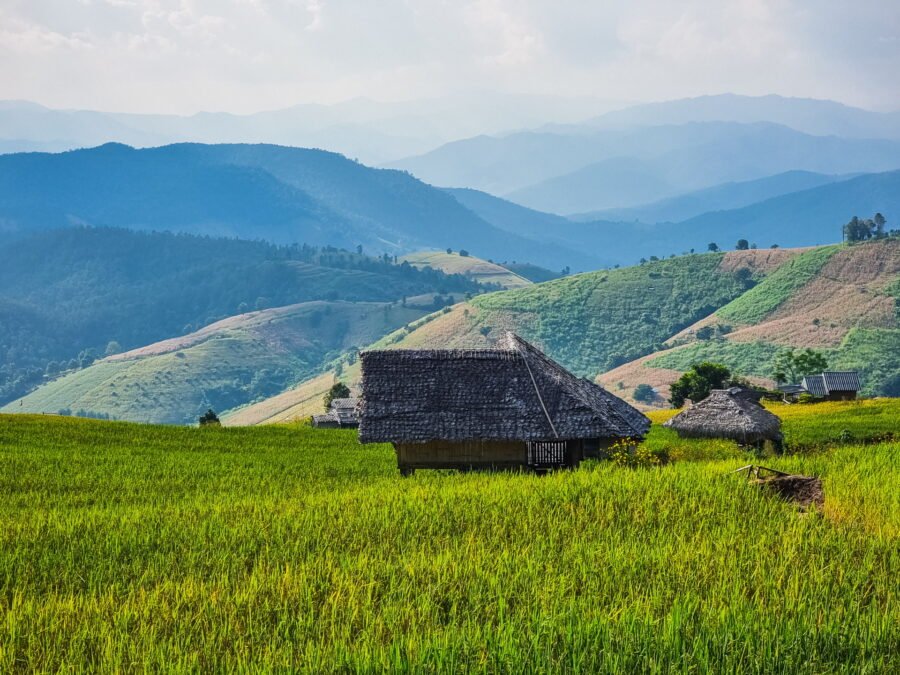
For those looking for magnificent rice terraces, you should look more towards Vietnam, as we had the opportunity to get a glimpse of during our roadtrip in the north of the country. I can also mention China, which has them in spades, Bali, which remains quite popular for that too (although it is not the primary attraction) or even the Philippines (the best known being the rice fields of Banaue).
That being said, any rice paddy has something beautiful about it, even on a flat surface. That famous green color, the presence of water and those apparent reflections, clearly visible when the rice has just been planted, the changing colors with the season, especially its golden color just before harvest, that's what makes a rice paddy so attractive.
But if you had to choose, it's better in the mountains and Ban Pa Pong Piang is the perfect spot for those who want to visit Thailand while admiring beautiful rice terraces.
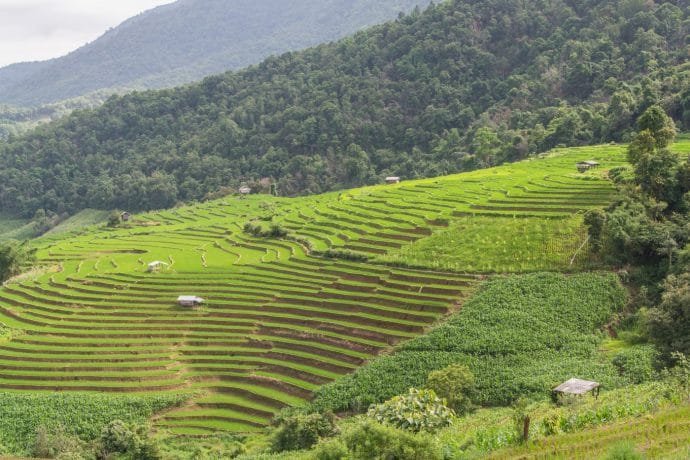
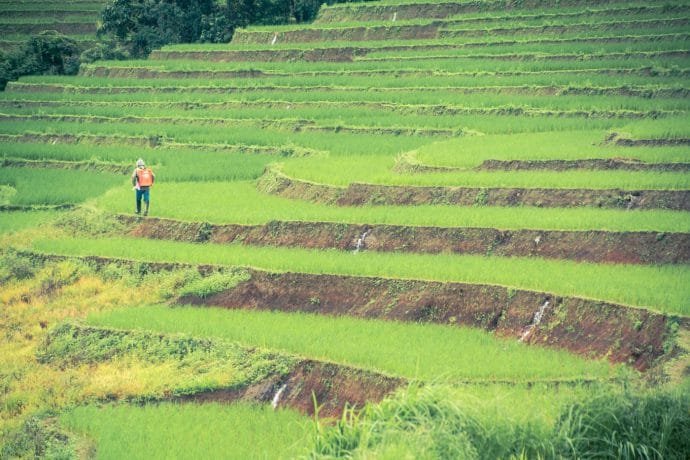

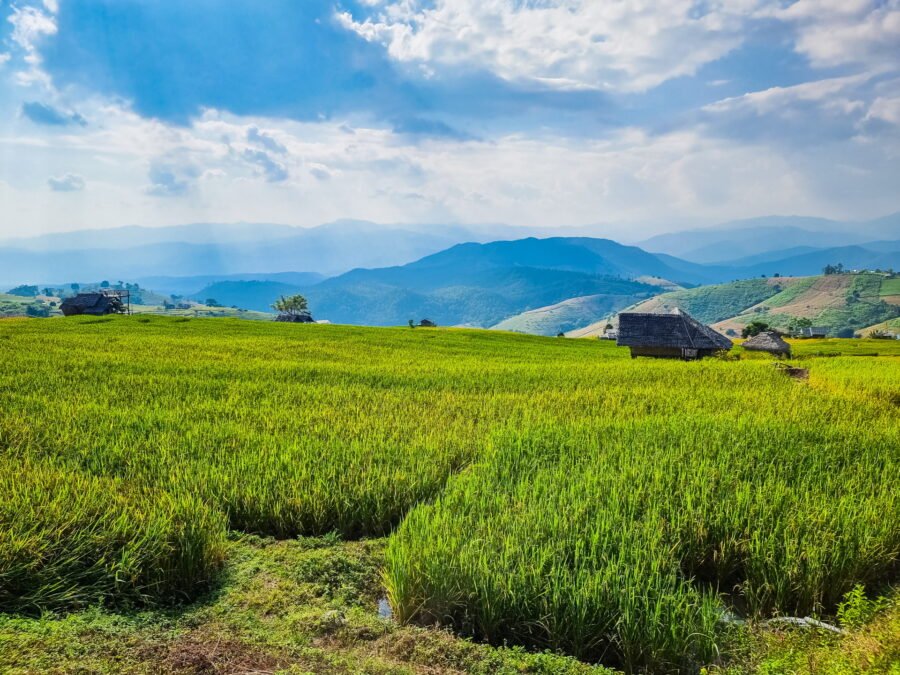
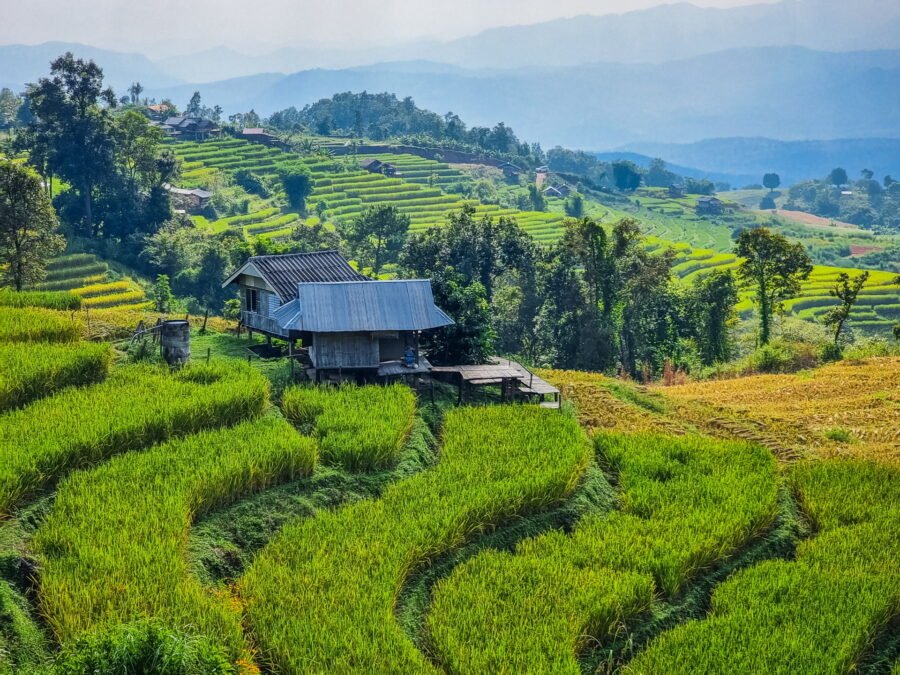
What to do in Ban Pa Pong Pieng
During the day, if you stay there, you can relax on the terrace of your cabin, otherwise, you can walk in the rice fields. Even without sleeping on site, it is possible to follow small paths allowing access to the middle of the latter. If you sleep on site, in addition to the fact that some cabins are themselves in the middle of the rice fields, others generally have access arranged to approach.
Depending on the time of year, you may have the opportunity to observe the locals who sometimes come to work in their fields. Apart from the presence of the rice fields, the view of the mountains is breathtaking in itself, you can see all the way to the mountain range on the other side of the valley, where the small town of Mae Chaem is located below.
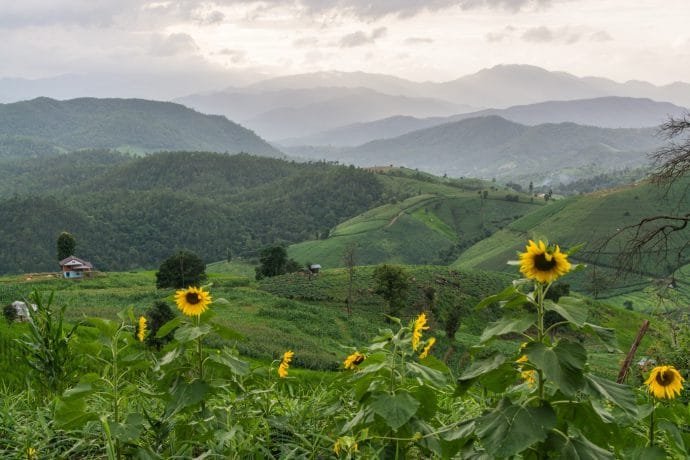

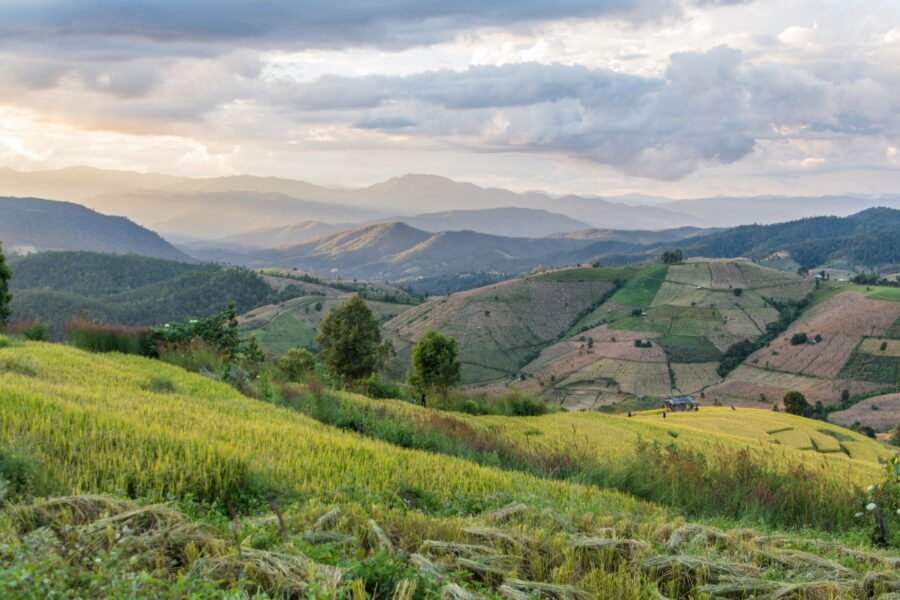
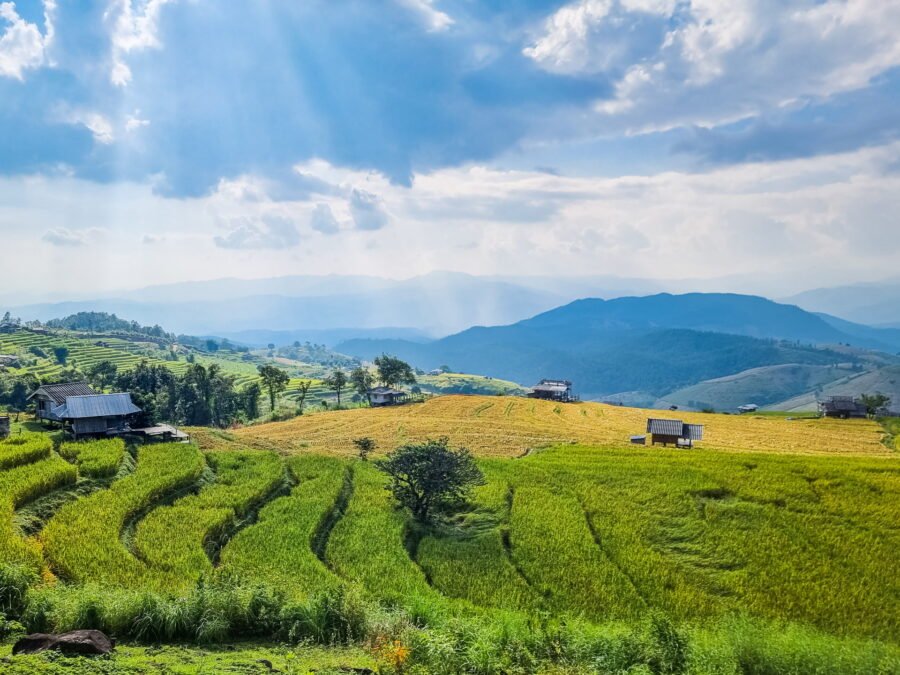
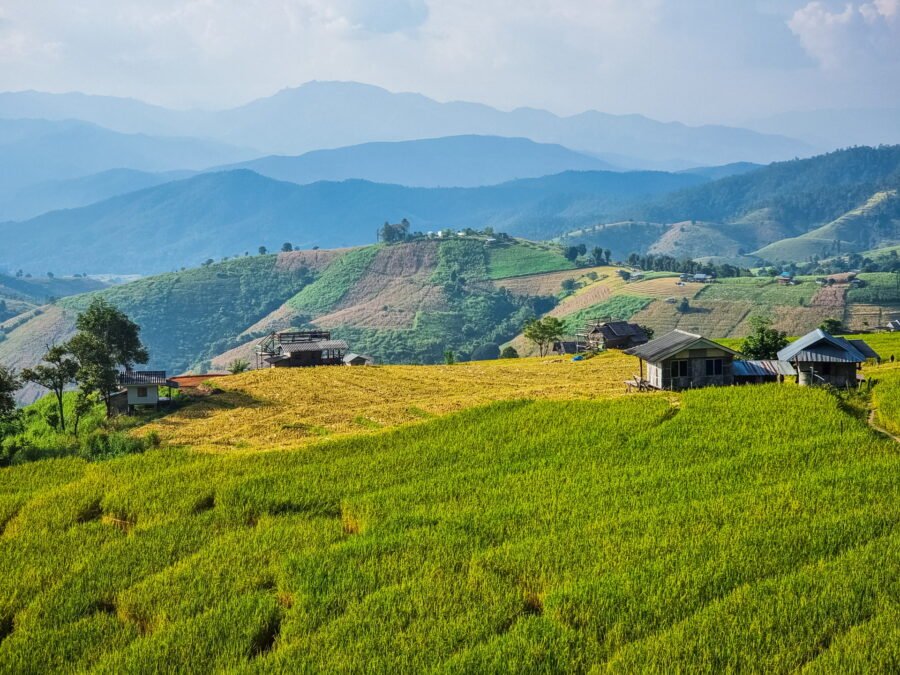
If you're going to come to the area, I can only suggest staying there to sleep, whether it's to admire the sunset (which is bowing out right in front of you, behind the mountains in the distance), or to admire the morning fog filling the valley and the colors of the sunrise. These two moments of the day are already worth the trip all the way there.
It is also an opportunity to try a very local meal, to recharge your batteries, to put your smartphone aside for a while and focus on people. As there is no electricity, no wifi, a deck of cards is not too much to spend a quiet evening. In the evening, if the sky is clear, you can enjoy a beautiful starry night, because apart from Mae Chaem, the nearest town whose lights can be seen below, there is very little light pollution.
Below, a small series taken in the morning:

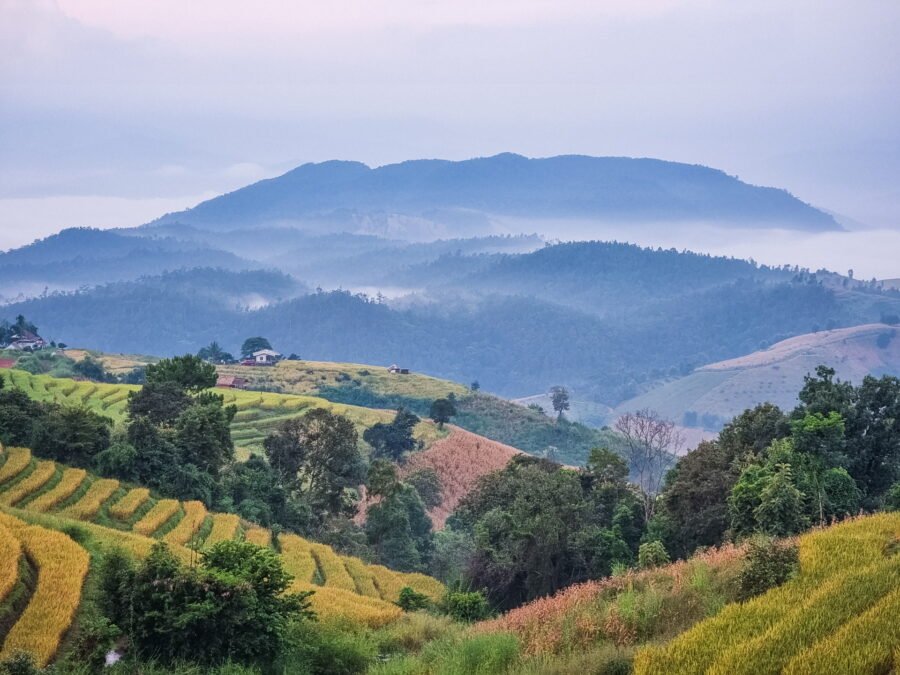


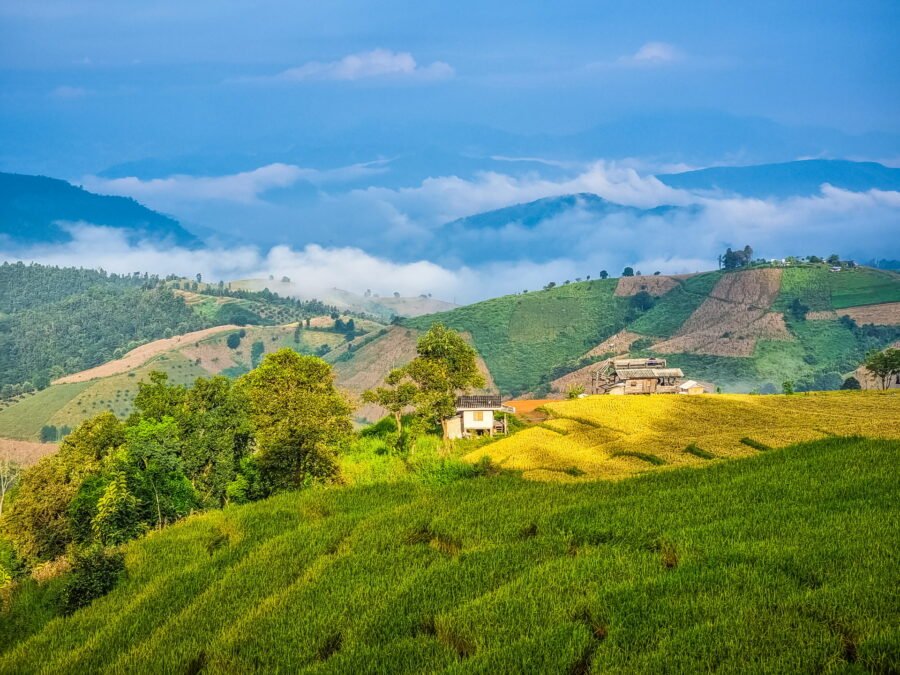


And for contrast, here is a series taken in the evening:
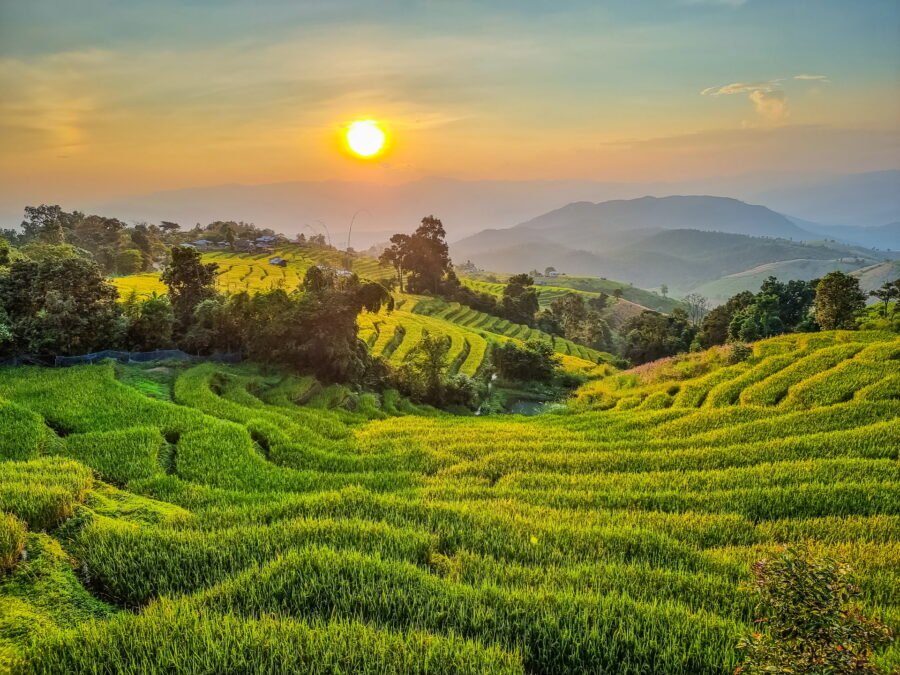

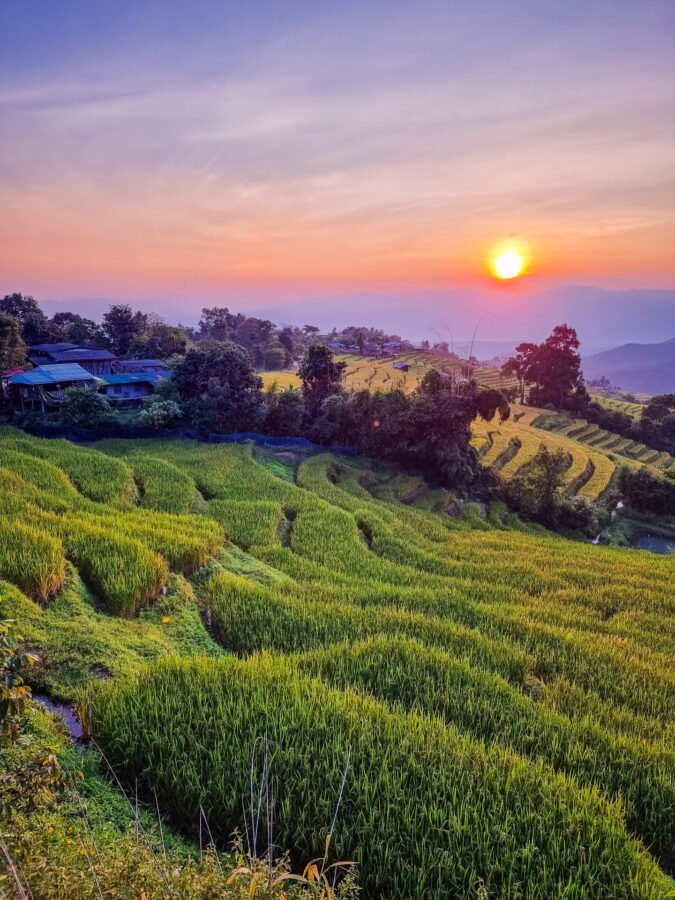



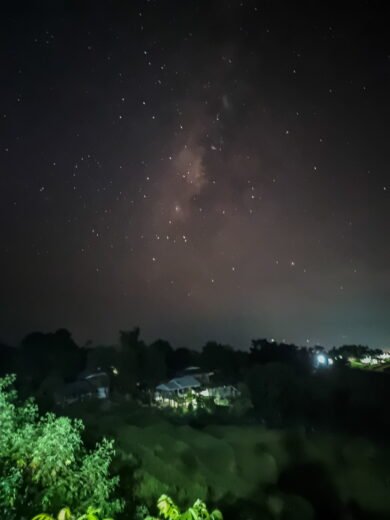
If you want to see some local life, there is not much in Ban Pa Pong Piang itself, which is basically its church and a few houses. On the other hand, if you have time and want to walk a little, you have 2,5 km to the village of Ban Tin Pha. In doing so, it allows you to see another side of the mountain, whose crops are also devoted to corn. Just like Pa Pong Piang, it is a Karen village.




Still if walking is not a problem, there are not one but three waterfalls 2 km away on the other side. Now that there is a proper road, you can indeed reach the Mae Pan Falls campsite on foot. In doing so, at the small bridge just before the campsite, you will see an access path to the first waterfall in the area, Pha Sam Lan. This is the only one I did not see because before, only a muddy road led to this area.
Another waterfall is very easy to access because it is located just 120 m from the parking lot, Huai Sai Lueang, a small waterfall on two levels with its charm since it is surrounded by the jungle, and generally, there are few people compared to the rest of the falls located in the main area of the national park.

Finally the last one, giving its name to the campsite, the Mae Pan Waterfall is located in an isolated area. From the junction leading to Ban Pa Pong Pieng, you have to follow a small road for a little less than 300 m to arrive at the waterfall car park. Then, a good little walk of 800 m awaits you. It is in the middle of the jungle so watch out for snakes. You follow a fairly narrow path for a good part, on the mountainside, with the river below.


Where to sleep in Ban Pa Pong Pieng?
The houses to sleep on site normally have neither electricity (in the sense of permanent), nor hot water so… But that’s almost also why we come here! A real return to “the sources” (well, I say that, but I still have 4G…)
You will be provided with candles to light up the evening or depending on the guesthouse, you may be entitled to LED bulbs which light up rather well (working via solar panels). Still, have at least one flashlight, it can always be useful.

One downside, however, given the character of the place, if you don't speak Thai, it can be complicated to book and get there. However, not knowing how to write Thai, I was still able to book in English, via 2 different guest houses.
This is a “principle” reservation, payment is made on site in cash (so plan ahead, because obviously there are no cash machines in the area…)
Here are their contacts:
- Sombutchai Mju, which can be found on Facebook. He is a young man whose family owned land on this mountainside and who built the accommodation himself with his uncle, originally consisting of 2 houses, one with 2 bedrooms (for 2 people each) and another with a single bedroom (for 2 people): Sombutchai Housing Facebook Page
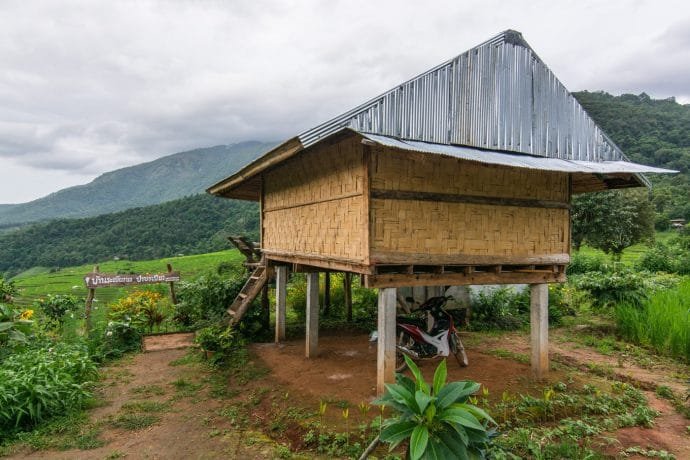

– As Sombutchai was full last time, I turned to Khun Da’s, here is his Facebook profile and his page, Baan Num Pu (pronounced Banne Nâm Pou). The view is particularly nice, because you are really facing the mountain, Sombutchai's accommodation being more on the side (but the view is good too). We can see that the business is profitable, because since my first time here (Sombutchai is more often full), the terrace has grown, the bathroom is now at the height of the house, less rustic than the one previously at the bottom of the stilts.
– As a possible alternative, you can also try to contact Weerasuk Homestay: Facebook of Weerasuk Homestay, but I have never tested it yet.
Finally, if you don't find what you're looking for, but are motivated, you will find other contacts on this page, in Thai by the way, you can see other photos of the place and the accommodation available:
You can use automatic translation (if you use Chrome for example) to help you find the relevant paragraph. To help you find your way, you have for example the last telephone number of the paragraph in question, 080 794 6883, which corresponds to Sombutchai's number above.
When to come to Ban Pa Pong Piang?
Knowing that in addition to the view, the main attraction is above all the rice fields, it is obvious to favor the right season. It is from July that the plantations will take place, so the period July / August will allow to see the young shoots, letting see the apparent water, good to see beautiful reflections and play with the angles of photos.


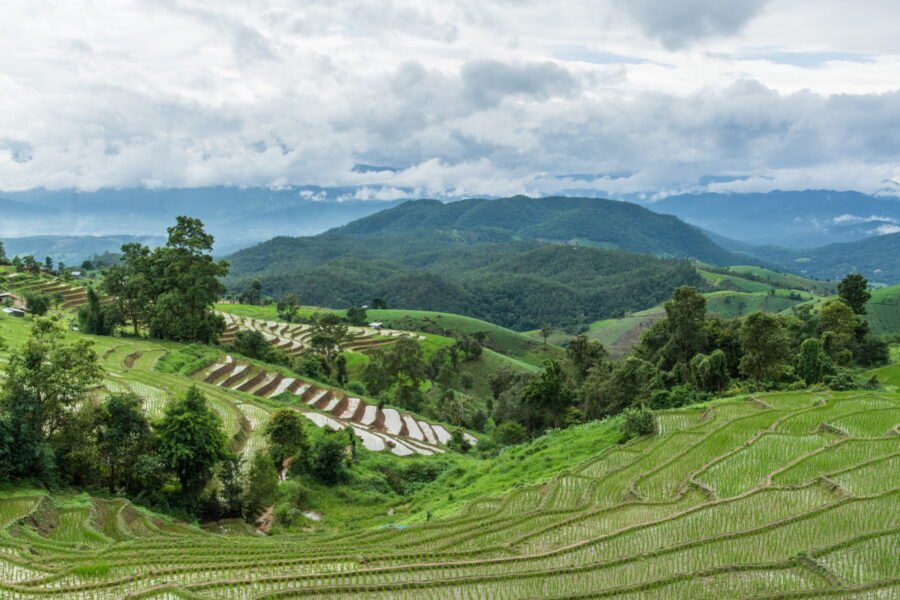

By September and early October, the rice will have grown well and will be very green, perfect if it is this beautiful green that interests you, the fields will be full of it! However, this is the rainiest period, so take that into account. From the end of October, the chances of having good weather increase and the rice fields are then very full, with a rice shoot that is growing taller.
Finally, you have until mid-November max to go to Ban Pa Pong Piang and have rice fields still full. Shortly before the harvest, the rice turns yellow and offers green and golden hues contrasting with the green of the mountains and the vegetation surrounding the rice fields. Even if generally the harvest has already started at this time, there will still be some plots still planted and those already harvested leave golden stems on the ground which make a visual rendering remaining interesting. It is beyond this period that Ban Pa Pong Piang will lose its charm, because if the landscape remains pleasant until the beginning of February, the rice fields will be empty and dry.


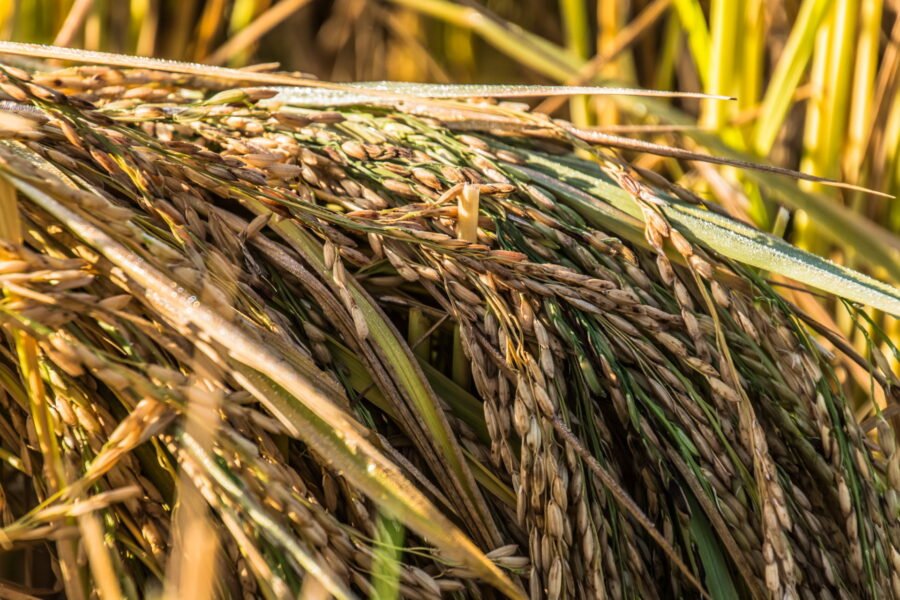
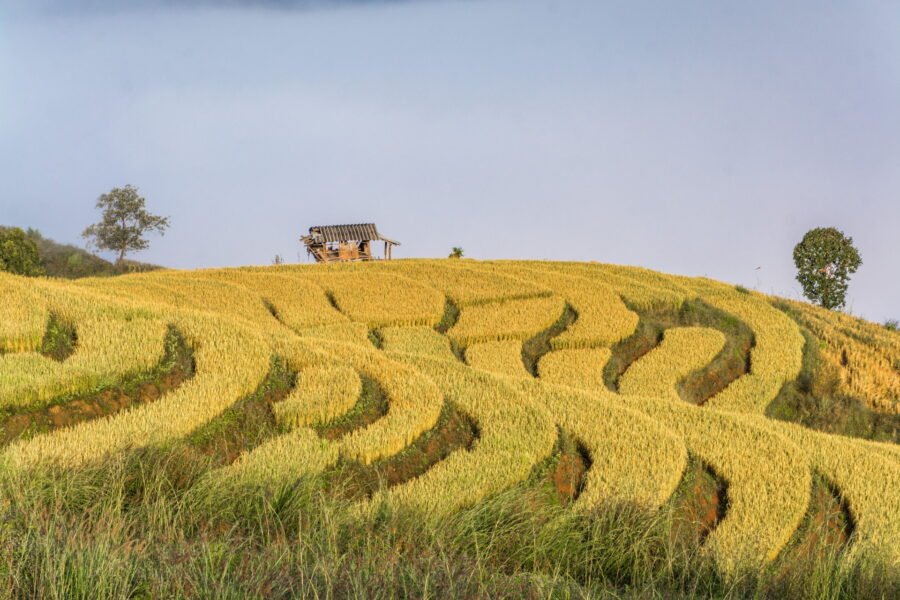



Beyond February, it will be the hottest season in Thailand, it is the burning season, with a landscape suddenly foggy, a completely dried nature, going to Ban Pa Pong Piang around March-April clearly loses its interest.
How to get to Ban Pa Pong Piang?
– By yourself: Warning! It is essential to have an all-terrain vehicle (4-wheel drive) and to feel comfortable in this type of mountain driving exercise. Also feasible on a motocross bike but not on a scooter during the rainy season.
With the construction of the permanent road, this remark is no longer relevant. I want to leave it legible, as a vestige of the past, reminding us that some places becoming popular can quickly change (at least among locals, because to date, relatively few foreigners go there, but for how long given the now much easier access).
In any case, there are at least 3 possible passages leading to the top.
- The first is the shortest version, you have to go to the Mae Pan waterfall camp, on the road to Mae Chaem then turn left before reaching the parking lot to see the waterfall. You will then be on a small road, which first goes down to a small bridge crossing a stream then goes back up to Ban Pa Pong Piang for a little less than 3 km. To see the change, I kept the original photo on the left.
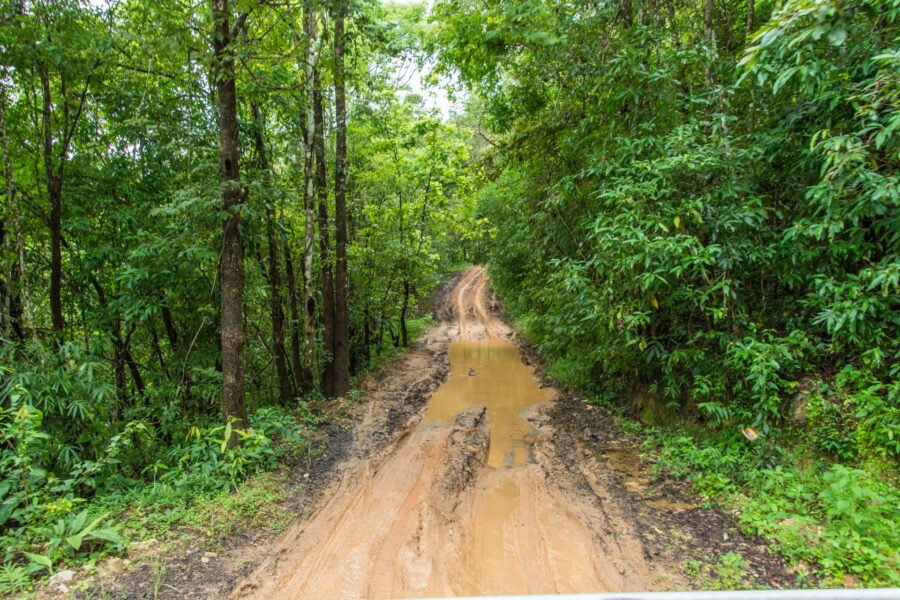

And here same thing, on the left the path up vs now.


- The second is the option that was suggested to me by Google Maps, which did not see at the time a connection between the Mae Pan Waterfall camp and the road leading to the top (now that the road in question is made, it appears there). Instead of turning right at the road leading to the Mae Pan waterfall, you have to continue on the main road (the 1192) for about 6 km then turn right (more precisely, the main road will turn left, but you have to go straight towards a small concrete road at first, then dirt later). It adds 10 km, but allows you to see beautiful landscapes during the climb. On the other hand, it is a dirt road and a 4X4 is essential (otherwise I would not have passed one of the last turns…).

Landscape from an access road to Ban Pa Pong Piang. 
A very useful tool! 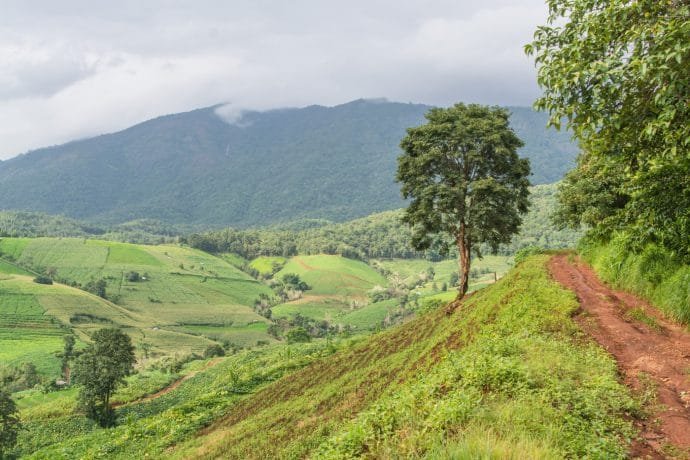
Dirt road. - The third and final option is the longest, tested recently. It makes a huge detour as such since you have to go back down to Mae Chaem, continue up north for a few kilometers to the town of Thung Yao. A small road then goes into the mountain and passes through several villages before reaching Ban Pa Pong Piang. Contrary to what I thought, the road after the first village crossed is not tarred or concreted, but just dirt. As I had come across city cars at the top, before the road from Mae Pan was made, I thought access would be easy from this side. Personally, I recommend having a pick-up at the risk of damaging the underbody. The advantage of this option is that you come across local life, between the cows at the side of the road, the farmers working in the fields, the villages, it is a window on the surrounding countryside. An interesting option is to come to Ban Pa Pong Piang by the small road directly from Mae Pan, and on the way back, take this path.

Church in a village. 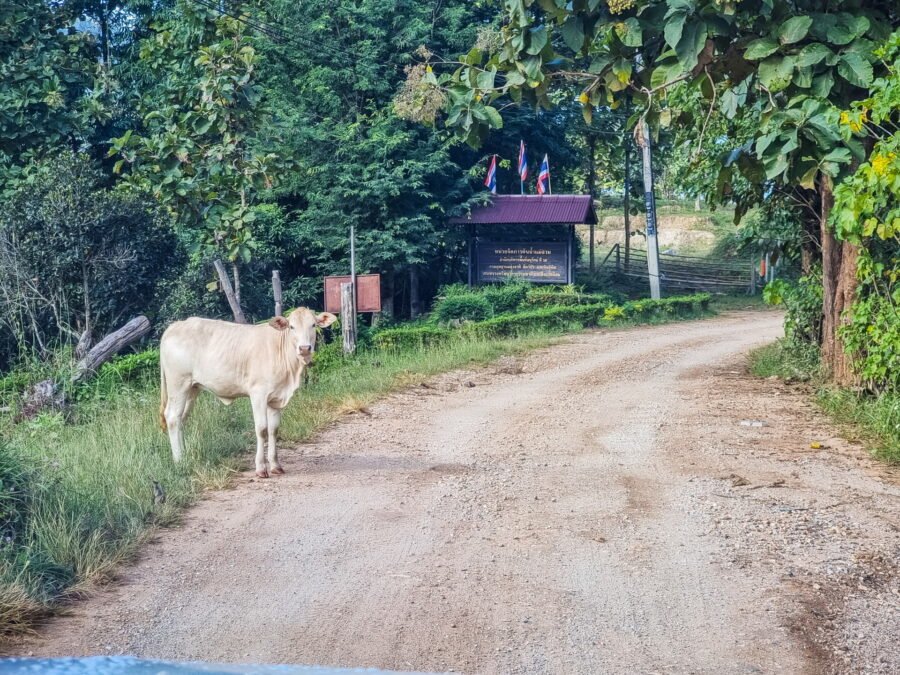
Cow by the side of the road. 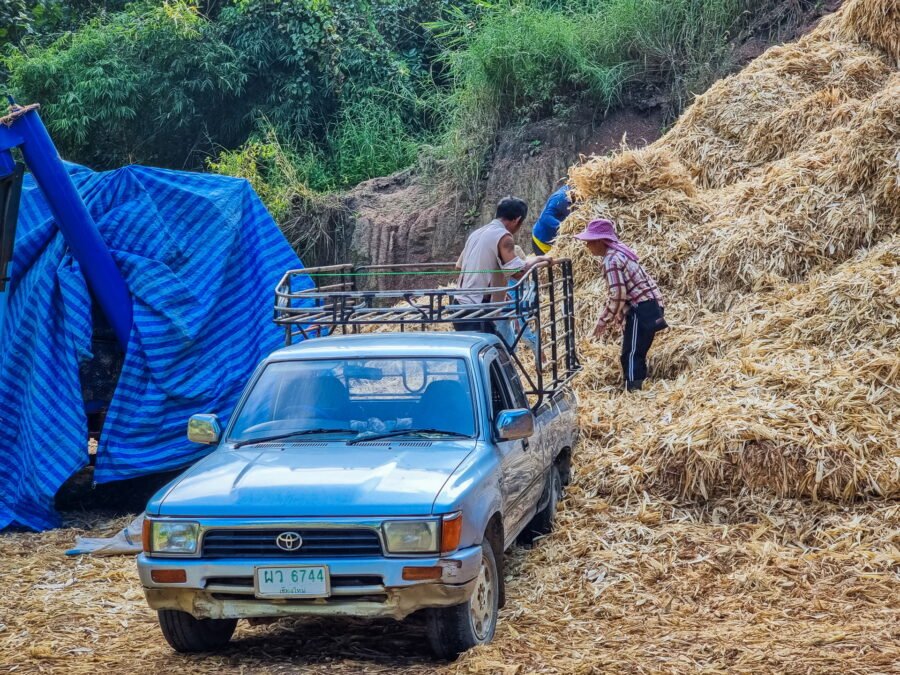
Scene of life along the road. 
Buffaloes crossed along the path.
Which gives this on a map:
– By public transport: From Chiang Mai, you need to take a songthaew, these shared taxis which are pick-up trucks with rows of seats in the back, in this case, yellow (the red ones only make connections in the city center and nearby areas). In addition to using these for visit Doi Inthanon National Park During the day, ask to be dropped off at Ban Pa Pong Piang. On my last trip, I came across a red songthaew there, proof that it must also be possible to rent these to get there.
And now that the road is paved, access is even easier.
So, are you motivated to go there?
Did you like the article? share on Pinterest!
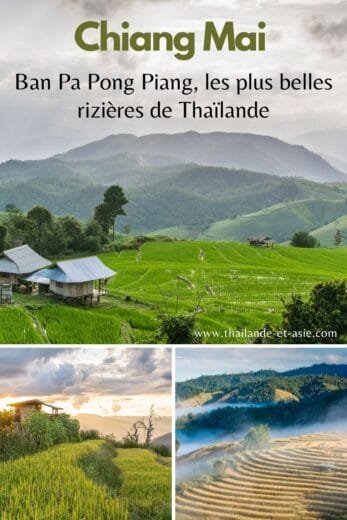



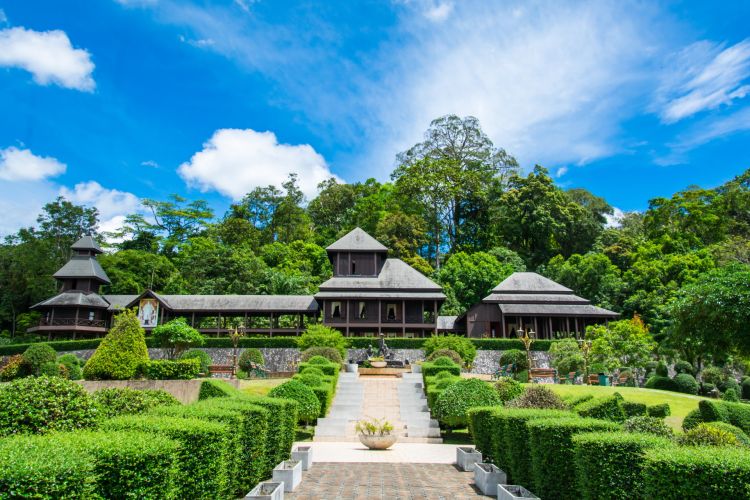
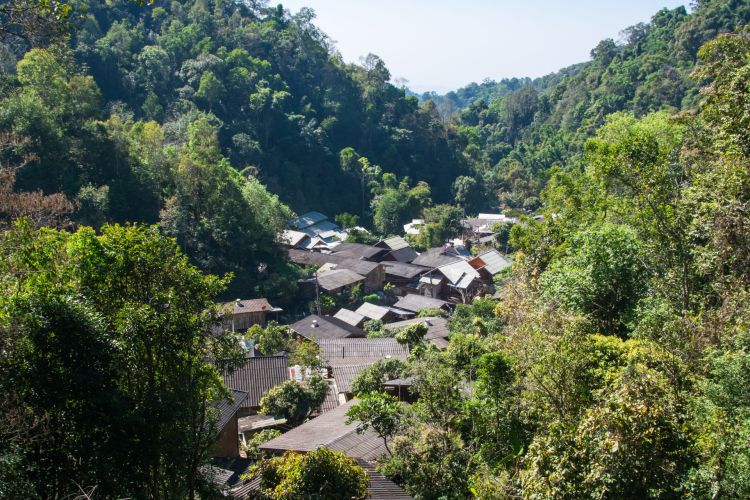
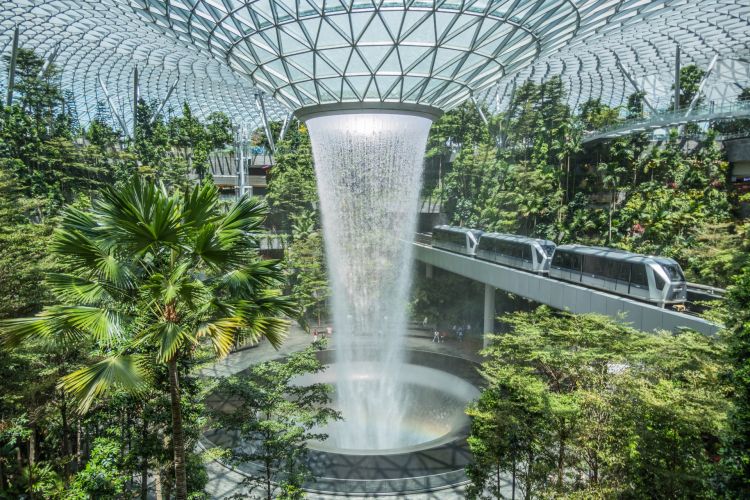
38 Comments
Your articles are always very interesting. Thanks Romain
Beautiful photos and beautiful report. I will keep it in mind for our next trip to Chiang Mai.
Thank you
Bravo Romain for all this work. I know the area around Chang Mai well. I have been in Nong Ki near Buriram for almost five years where I raise fish. Happy birthday for your 10 years in Asia. Choke Dee Romain for 2017 and again congratulations for your blog for all lovers of Thailand.
Thank you Romain for this excellent and very detailed article which really made us want to discover this wonderful place. For now it is too late to go up there, the harvests must be done. We will wait for the next plantations for a first visit (July? August?).
We have been established in Chiang Mai for two years. We are fans of scooter trips and amateur photographers. Do not hesitate to contact me for a possible meeting if you come back for a ride in the North!
Hello and thank you for your message of support! Small clarification, if it's been 10 years since I came to Thailand for the first time, it's been 8 years since I've lived there, 2 more years to celebrate my 10 years in the land of smiles 😉
Hello,
I think we could get along, if I come back to the area I will contact you with pleasure! Thank you!
Hello
I just discovered your blog which is a goldmine for those who like to think outside the box.
I'm going to the area in 3 weeks but I guess there's no point in going there right now...
Can you imagine doing this walk on foot for a day, starting from the waterfall car park, especially if you only have a car?
Hello,
Let's say that without rice fields it loses a bit of its interest even if the view remains beautiful! If you are a good walker, it seems quite feasible to me, at this time of year the path should be dry and passable. After given the distance, it takes a good hour to get there from the waterfall car park.
Wow, this is amazing and I had never heard of this place!! I like your blog, you talk about a lot of little-known places in a much-visited country. Cool!
Thank you! The purpose of these articles is precisely to show that although it is visited a lot, the country remains full of surprises and does not have to be neglected for all that!
Hello Romain and congratulations for your blog. We are returning to Thailand for the 5th time and would like to discover these rice fields. However, we are coming at the end of May/beginning of June so I don't know what landscape to expect because I read on your blog that the planting is done at the beginning of July. What is the climate in this region on our dates? Thank you for your answer and good luck.
Hello,
It's hard to say exactly what the rice fields will look like at that time, normally they will just be empty... It's the beginning of the rainy season, so storms are likely in the afternoon and/or evening, nothing insurmountable because during the day it can be nice. At least the landscapes will start to regain their greenery.
Thanks for the reply, we will review our plans… ,-)
Hello Romain and congratulations also for this great sharing!
we arrive in Bangkok next Tuesday and would really like to live this first Thai adventure in a very immersive way! these rice fields seem to me an ideal place to stay but I wanted to have your opinion, given the time of year we are coming. Do you think that despite the season, not necessarily optimal, we would rather visit these beautiful rice fields?
Hello,
The fact is that there shouldn't be any rice fields at this time of year... If you can see some in the surrounding plains, it's basically not the right time so some fields have replanted rice, others haven't... You'd have to go there for that between August and November.
Hello,
What do you think of the month of February to visit this magical place?
Hello,
Let's say it's not ideal in the sense that there shouldn't be a rice field... but if you have the opportunity, why not 😉
Hello Romain,
I am coming to you to get information regarding this article,
Me and my family are going to Thailand in December and we want to visit this place mentioned in your article.
I wanted to know if we can go there with a 5 year old child, is there any walking involved?
Thank you for your answers Romain.
Hello,
It is absolutely possible to go there with a child, there is normally no walking involved since access is by pick-up from a dirt road starting from the ranger station at Mae Pan waterfall as mentioned in the article.
Hello Romain,
Thank you for this article that makes you want to go! I'm going to Chiang Mai mid-September.. I want to get out of the city and this type of excursion seems great to me.. only is it feasible by renting a car for 2 days with a night there? Google map gives about 2h30 of travel.. I suppose it's a bit utopian..
Thanks in advance for your details 🙂
Hello,
Timing-wise it's still doable. For my part I did this visit from Chom Tong, at the foot of Doi Inthanon, which saved a good hour of driving. On the other hand, if you plan to go there by yourself, I would like to remind you that you need a 4×4 and be at least a little experienced in this type of driving, September being particularly rainy, the road will be particularly muddy.
Hello Romain,
Thank you first for all these good tips and advice. A friend and I are going to Thailand from November 9th (for a backpacking trip through South East Asia) and we want to make our first stop in the Doi Inthanon National Park. We would like to see the rice terraces of Baan Pa Pong Pieng (the rice will not be harvested yet?) that you talk about in this article (spend a night there if possible) but also go see the 2 pagodas Phra Mahathat Naphamethanidon and Phra Mahathat Naphaphonphumisir and possibly see some waterfalls in the park if we have time.
1- How many days do you think it will take us to make this round trip from Chiang Mai? (because we have a tight schedule and would like to take a plane from Chiang Mai to go elsewhere afterwards) (we don't really know the transport times from Chiang Mai etc.)
2- How is transportation inside Doi Inthanon Park? Can everything be done by "songtaew" from Chiang Mai? And if we spend a night inside, is it possible to find a means of internal transportation or at least a way to return to Chiang Mai? What alternative would be the most sensible in your opinion to get around without spending too much money but not wasting too much time either?
3- During our trip, we would also like to be able to go to an elephant sanctuary that respects the animals (not one that offers elephant rides) but simply to see them and be in contact with them. Do you have any particular recommendations? Is it better to go to one in the Chiang Mai region (if so, do you know of any?) or in the South for example? While researching on the internet, I came across "Wildlife Friends Foundation" located in the South of the country, which seems to be correct and which will be on our way at the end of the trip.
Thank you in advance for your help. We would be very grateful if you could answer our many questions. (Again sorry for the length…).
Sincerely,
Yohann.
Hello,
So, regarding the first question, normally no, the rice fields will not yet be harvested at this time.
1- I would say ideally 2 days and 1 night in Baan Pa Pong Pieng. From Chiang Mai to Doi Inthanon it is not that far, roughly it takes 2 hours.
2- From Chiang Mai, you have to take a songtaew from the north gate, Chang Phuak Gate. By privatizing it, it is quite possible to do everything with it in the day, except for going up to Baan Pa Pong Pieng which will have to be done separately from the Mae Pan waterfall. The easiest in absolute terms is to rent a scooter, again going up to the rice fields at the top does not seem feasible to me with a basic scooter, but on a motocross bike yes, however if you do not have a motorcycle license in France, I obviously do not recommend it.
3- The best known is the Elephant nature park In Chiang Mai, it is the sanctuary that started the craze for this type of tourism and interaction with elephants. However, the one you mention is also a safe and respectful value.
Thank you for your help,
Since we are backpacking and are used to walking, we were thinking of reaching Baan Pa Pong Pieng by walking from Mae Pan waterfall. Is it possible to walk (how long)?
Is it possible to meet a driver the next day at the waterfall to head back to Chiang Mai?
Thanks again,
Yohann.
It would be doable if the path was not muddy… Which I do not guarantee at the beginning of November… otherwise the distance as such is not really long, it is 1,5km (uphill)
Making an appointment could be a good idea, but we'll see how much it costs. I'm interested in your feedback in any case!
Hello, How are the rice fields in March? Thank you 😉
Hello,
I'm afraid they're empty and dry... The ideal period is between July and November.
Bravo and Thank you Romain! I am preparing a 15-day trip to Thailand next February and your site is really great, very clear, practical, full of tips… we will go as a family to visit Doi Inthanon and are thinking of staying 1 night there. Do you think
that a detour via Ba Pa Pong Pieng would be useful knowing that at this time the rice fields will be empty or dry? thank you in advance for your advice
Yours
Delphine
Hello and thank you for the compliment!
Let's say that since there are no rice fields, the site loses a little of its interest, but the landscape remains beautiful... Difficult to decide in short...
Thanks Romain, that’s a bit what I was thinking…
I think we will opt for a day trip to Doi Inthanon, because we already have a busy schedule planned.
We will keep you informed! Thanks again
There is indeed a lot to do already at Doi Inthanon. You're welcome 😉
Hello Romain
Are you still following your blog?
Really nice your blog! Thanks
Hello,
I am still active yes 🙂 even if these last weeks I have fallen behind, I always update and answer messages. Thank you!
Hello Romain,
And yes, we are already in 2023 and I wanted to first tell you that your articles are very good and interesting: thank you for this work.
At the same time, I wanted to know if you were still active in this corner of the planet because I would have one or two questions 😉
Thanks again for this in-depth work and your good tips on this beautiful country that I have been dreaming of discovering for a long time: arriving next November.
Hello,
Of course, still active and faithful to the post 😉
Hello Romain, thank you for all this very helpful information. I will be in Chiang Mai at the beginning of February 2024 and I would like to visit Doi Inthanon and do a trek there. I plan to stay one night in Ba Pa Pong Pieng. I would also like to know if you know a French-speaking guide, as I only speak French? Thank you, Marlene
Yours
Hello,
In Chiang Mai, I only know Bee (see here) otherwise there is Tee Watertown who speaks some but that could limit the interaction if you don't speak a word of English (which is a shame when you travel by the way).
I would like to point out that in February, you will not have rice fields in Ban Pa Pong Pieng, so the interest will be limited if you go there at this time of year.
Thank you for this wonderful article about Ban Pa Pong Piang! The pictures of the rice fields are simply amazing and make me want to discover this magical place. I love the idea of exploring lesser-known destinations in Thailand. Maybe I'll plan a trip soon!